Tactician Bucky Smith was a key member of the Australian team that achieved a resounding victory in the Audi Etchells World Championship 2009 held in Melbourne. Aboard the Jason Muir skippered Etchells, Racer XY, Smith and his fellow crew members Paul Wyatt and Matthew Chew worked as a highly polished team to finish 20 points ahead of the next team and to walk away from the World Championship with one race to spare.
At the completion of the Worlds Smith took time to analyse the team's program and racing strategy. What follows is a comprehensive and fascinating insight to the Muir campaign and how Smith (BS) contributed to the success of the team in the Worlds. Here he gives Tracey Johnstone (TJ) some insights into their victory...
TJ - Was Jason Muir clear on what your role was on board his boat for the Worlds?
BS - Jason asked me to come on board as tactician and headsail trimmer. The great part about that was Jason and his team were already very well rehearsed in running the boat, making it go fast. I was truly able to come on as tactician and focus 99 per cent of my attention on that task.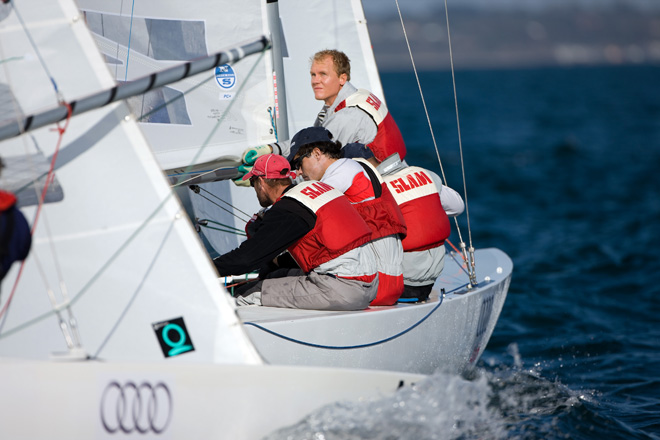
© afrancolini.com - Bucky Smith looking back at the opposition
I believe this was one of the keys to our success. I had all the tactical information at hand and was able to sit on the boat constantly running tactical options and scenarios through my mind to make my decisions. This would not have been achievable without Jason driving the boat perfectly, Matt making the boat go as fast as possible and giving me his tactical input as well, and especially without Paul keeping in my ear about our bigger picture strategy we had come up with before each race. He dealt with things like our overall positioning on the race course and the compass numbers info. This enabled me to make informed, quick decisions.
TJ - Once Muir had confirmed your inclusion in his team what did you do to prepare for the Worlds?
BS - Basically I came on board about four weeks before the Worlds. The boat was already prepared very well and was up to speed. We did a few club races together and the Brisbane Fleet Championship, which we won. After the fleet championships we were able to identify areas of improvement in our on-water processes including crew work, tactical information gathering, starting strategy and decision making.
We then took the boat to Melbourne and did the Entire Pre-Worlds regatta. There we kept building on what we were learning about how we were racing the boat, interacting and communicating on board. Unfortunately, the weather in Melbourne during the week before the Worlds prevented us from doing much non-race training, but I was always confident in our boat speed and our race processes were coming together well. We spent a lot of time that week working on the boat and preparing it for the Worlds in terms of fittings, polishing, etc. The boat must have been the most well polished boat there after we were done with it that week!
TJ - What preparations did you do during the Entire Pre-Worlds event as a precursor to the Worlds?
BS - The Pre-Worlds was our main preparation in all areas, but most particularly our starting, use of the weather models and tactical decision making. Unfortunately, we scored an OCS in the Pre-Worlds so our overall result didn't look too good, but we were happy with our progress, our boat speed during this regatta and our on-water processes were beginning to click. This regatta also gave us a bit of an idea of "who's who in the zoo" in terms of competitors, who was fast and so on.
TJ - How aware were you of your Worlds competition and what did you do to in response to this competition?
BS - The Pre-Worlds regatta gave us a good idea of the main competition and really just confirmed in our minds which of the teams were fast. In terms of specific competitors I have always maintained that I was well aware of the calibre of who we were up against. Every race I was well aware of the company we were in.
I had the utmost respect for competitors like John Bertrand (and his team of Ben Ainslie and Andrew Palfrey), Jud Smith, Chris Bush, Stuart Childerly, even the Barry boys, along with many others in the fleet. In fact, we went through the entry list after the Pre-Worlds and specifically identified who we thought were going to be the top ten. This was tough because so many were top crews. We memorised their bow numbers and sail numbers and the Barry boys were on the list right from the start. This made it much easier to know who was where on the race course and I think this is a testament to how much respect we had for the fleet basing some of our decision making on where our top competitors were positioning themselves on the race course.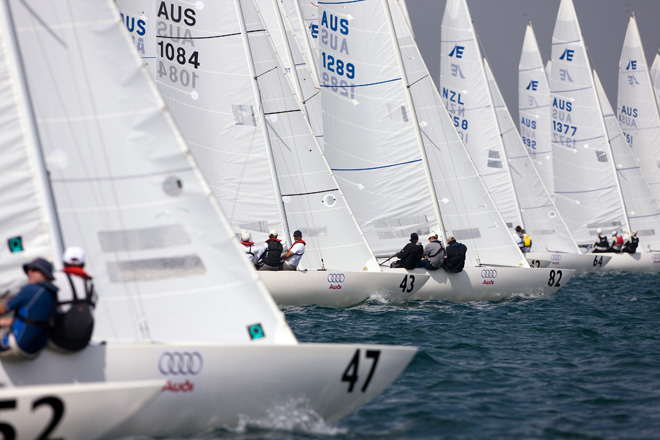
© afrancolini.com - Lots of traffic in the Etchells Worlds
TJ - For each race day what were your preparations?
BS - One of the main things we focussed on was our routine. It became mechanical, second nature. First up was meeting at Jason's unit. We would get our gear together, check our weights on the scales, then head down to the cafe next to the Royal Brighton Yacht Club. Every morning we had a coffee at this cafe and went through the day's weather forecasts and models for a good 45 minutes. We would discuss different race strategies, scenarios, start line situations and have a look over the results as they progressed.
I would write down all the weather model data I was using and things to watch out for on the race course for the day and take this to the boat when Matt was giving the bottom of the boat a wash. We didn't really have set times to leave the dock, nor did we try to be first on the water each day, we just followed our own routine and stayed focussed.
On the water we did the usual tactical data information gathering in terms of wind directions, what the wind was doing in terms of wind shifts, how close the wind was to the weather models I had, upwind and downwind sailing angles, wind strength, headsail choice and rig setup. All this all usually occurred up to about ten minutes to the warning signal. Then we focussed on start line angle and line bias, head to wind angles, taking our start line transit and determining what phase the wind was in, what side of the course may be favoured and what would be the favoured tack after the start particularly during the five minute starting sequence period.
We wanted to have our place on the line decided before three minutes to go particularly because the light winds meant it was hard to get to the end of the line in time and I wanted to make sure we were in place for the first shift or to have the ability to position ourselves after the start to what I thought would be the favoured side of the course. Mind you, we didn't get this right every time!.
We re-did this pre-start process if there was a general recall. We were bitten in the pre-worlds where our OCS was due to the line being moved after a general recall and I didn't re-take the transit. I was convinced we were not over on that start; on the old transit that is!!
So we made a good point of going through our process again each time and checking for changes.
TJ - How did you approach each race day in terms of strategy?
BS - Our strategy was initially formulated based on the weather models I was getting, looking at the start time and what the weather models were saying the wind would do around that time. It was then finalised on-water when I was able to compare what the wind was actually doing to the weather models predictions and my own personal judgements. An overall start and first beat strategy was usually agreed upon by ten minutes to go to the warning signal. We also had to adapt to any changes in the final 15 minutes to the start. We changed strategy only a couple of times with five minutes to go. I even changed strategy after the start if needed, particularly in Race 7 when the big left-hand, backing shift caught me out.
The other main element of our individual race strategy was our overall regatta strategy. My plan was top 15 places in the races would be respectable, consistent top ten placing would put us in the top five overall and in a position to play the game at the end of the regatta, and top five placing on average would easily win the regatta. This meant we had a mistake and risk-minimising strategy, but taking the opportunities as they presented themselves.
Essentially, keeping it clean at the start, getting on the lifted tack or head to what I thought was the favoured side of the course, getting the boat going as fast as possible for as long as possible, minimising tacks upwind to keep the boat at full speed as long as possible in the lighter conditions, sailing in lanes of clear air, staying in phase, and so on, achieving top 15 at the top mark, chipping away from there if the opportunity presented itself to win a race later in the regatta then we could get a bit of separation and leverage, but not risk losing places in the process. Easier said than done though !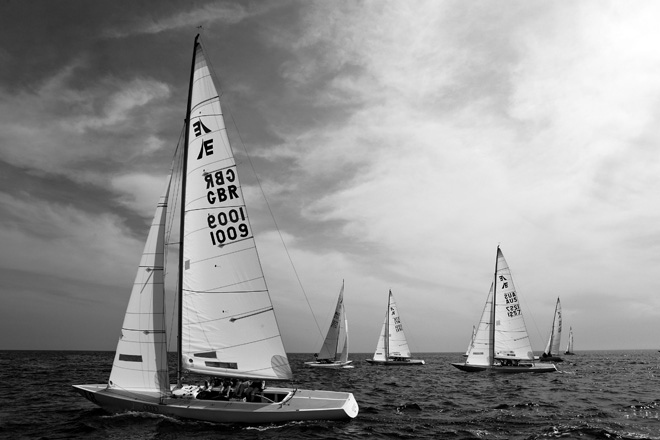
© afrancolini.com
We had a stab at Race 6, the windier race, when the top four boats were well clear, that is us, Bertrand, Childerly and Taylor. We saw some pressure up the last beat to the right and tacked away from the top four bunch not risking places behind. We actually hit the pressure and tacked back onto a good 20 degree lift which looked very nice, but the pressure and lift only lasted about one minute and we came back in fourth. That was the only time winning a race crossed my mind. A top five placing was my aim each time.
TJ - What were you and the team doing in the race in terms of on-water tactics? Who did what and what were the key activities that really made the difference in your performance?
BS - Jason steered the boat fast. Matt made the boat go fast with rig setup and mainsail trim. Paul did higher-level strategy and compass numbers and kept in my ear the whole time about all his thoughts, I did tactics and headsail trim.
Obviously, I didn't do tactics in isolation. I ran ideas past all the boys and often tacking or gybing was a confirmation from Paul or Matt. The key about this was we really came together as a champion team and we all performed our tasks well individually which meant each other person didn't have to give anyone else's task a second thought.
Jason and the boys put a lot of trust in me tactically, but operating in their team environment made performing the job easy. There was no second guessing, no issues, just positive comments and tactical contribution from the boys with information and ideas to consider before I made the hard decisions. I will say though that when the chips were down the boys did go a bit quiet here and there ! But really, they put a lot of faith in me and I'm very proud and relieved at the same time we were able to put together such a clean consistent scorecard.
TJ - Did you study Bertrand's start tactics from the first few races to determine whether you would follow his start and course decisions or make your own "path" to each mark?
BS - We went home every night and studied inside out the Tack Tracker software for each race. We knew where every top boat was tending to start on the line, what they were doing on the first beats. We tried to decipher their on-water tactics and strategy from this. It was a great tool of which we took full advantage.
In the end though we made our own decisions based on our own data and information gathering. This is particularly evident on the last two races, Races 7 and 8, where you can see we separated from John (Bertrand) a bit on the first beats. However, I did have this in mind in Race 8 when I was choosing where to start on the line. I wanted to be five or ten lengths up on the line in a nice lane from John and continue out for a bit and see where we were on the first cross, then consider how things looked after that.
TJ - What preparations did you do for second last day of racing knowing you were on the brink of potentially winning the Worlds?
BS - We didn't do extra or unusual preparations. We decided over our morning coffee to change very little in our preparations; just go out there and continue to do our thing, follow our processes, be consistent. We would see how the cards fell during Race 8.
The thought of winning the Worlds with a race to spare only entered my mind after Race 7 when we closed in on John on the overall points by a couple of points. I was fully aware of the situation. If John had one more high-scoring result and we kept it clean in the top five or ten in Race 8, we could take it out then and there. I didn't say anything to the boys on board to keep the pressure down. I know Matt and Paul were thinking about it too, but it just didn't come out because we were so focussed on our pre-start processes.
About the only thing we did differently was write down the scores of each boat in the top five that morning to take out with us so we knew the score.
TJ - How did you approach Race 7 - tactics, crew psychology, boat preparation?
BS - Our same pre-race preparation and processes took place off the water, on the water and in the prestart. I'm sure there were more nerves than usual involved this day, but for some reason I had the same feeling of confidence in our processes and to be honest this confidence built and built with every race and every top five or top ten finish. On the morning of that race day we did a few double checks on equipment just before leaving the dock; pulled out the tools and checked every shackle, nut, bolt, screw, knot, sail, the rig, etc.
TJ - How did you feel at the end of Race 7?
BS - Nervous, but confident. We had so many boats sail past us in between races 7 and 8 and give us support and this help some suggesting we engage in a close quarters match with John. But we discussed it and decided the odds were on them for a match race and we would most probably end up on the protest room if we went near John, Ben and Andrew in the pre-start. We had so much respect for this team that I decided on my race plan between races to set up on the line five or ten lengths above them to give us both room but be close enough to be in touch with them on the first cross or half way up the beat.
TJ - What did the team agree on for tactics in race 8?
BS - Our over-riding strategy throughout the preceding days was to keep getting our conservative top ten placing and hope each team that was in contention would stumble and we wouldn't. By Race 8 it was realistically us and John left for the title. He already had his BFD, but that didn't matter to me because looking at Ben's results over the years he has come back and won from some high-scoring early races. We were full of respect for the fact the BFD probably wasn't on Ben's mind all that much; they would just come out and get a top five placing in every other race no problems and they were doing it before our eyes. Race 7 got us closer to them, but they were still leading the regatta and not looking like doing anything other than winning.
Our individual race strategy was to start five or ten lengths up the line from John, get a clean start, sail out on starboard as long as possible in a clear lane until the race course opened up a bit, monitor John coming off the line, get in phase with the shifts as soon as possible and analyse things from there. But, unlike Race 7 where we got a perfect start, in Race 8 we actually got a poor start and got squeezed by the boat on our lee-bow. I spent a bit of time looking up the line for a gap to open up to either tack up into and resume starboard tack again or to be spat out from the front row into clear air on port tack. We tacked from being squeezed and took a few sterns.
The gap I had my eye on opened up and we had the opportunity to tack back into the front row again or cross and continue out into clear air on port tack. Luckily I glanced at the compass and commented to Paul we were actually on a good lift on port tack so I thought we should continue on. Also, Graeme Taylor, eventual Race 8 winner, was crossing the fleet just in front of us on port tack. Looking at the angles led me to believe he was probably the lead boat at the time. We continued on port, sailed into pressure and a good knock, tacked onto starboard and crossed 90 per cent of the fleet on good numbers and pressure. My main task then was to try and see where John was. I had been loosely watching his section of the line and his fleet positioning the whole time and when we tacked to starboard and crossed most the fleet I finally saw him a bit deep, but in clear air so he was still there.
I did a few quick counts and put him in the 20s and us in the top ten. Further up the beat, a quick count put us in the top five at the first rounding and when I explained the situation to the boys they snapped me out of focussing on behind and onto focussing on the boats around us and in front, and start sailing our race in the top five. We were not in a position to influence John's Race 8 result after the first beat so now every point between us and him counted for us so we sailed the race like we sailed every other race against the boats around us.
We came down the final run to the finish in fourth at the top mark. We actually dropped four boats on that run and came in at eight. We kicked ourselves for this because it was entirely possible those points could have been the difference between winning the regatta that day or having to sail off against John in the final race the next day. Watching where John was on the run all that was running through my mind was that it was entirely possible they were going to make a comeback down the last run and it was still ‘game on''. This shows the respect we had for them. We were not convinced of anything until we counted the boats between us at the finish and checked our scorecard calculations.
TJ - In summary, what was the winning formula for your team?
BS - The winning formula for our team was that we had four great guys having a lot of fun together out there. We did our individual jobs to the best of our abilities and developed that "champion team" environment on board. We focussed on the processes not the results in that we just aimed for top ten finishes and ultimately top five finishes and not for the "race win" which often requires taking too much risk to get. We stuck to our routine every day and I tried to make it as scientific as possible with the weather models, the wind angles and strengths on the race course and tactics, that is, as little guessing as possible. Our boat was well prepared and I was confident we had enough boat speed to be able to play the on-water "chess" game properly.
TJ - In breaking down this ‘winning formula', what priority would you put on each element?
BS - I think they are all equally as important as each other. Without a well prepared boat we would break something and maybe not finish a race. Without good crew work we would make a mistake at a mark rounding and drop 15 boats! Without good weather forecasts I would have been guessing too much on the wind and conditions for the day. Without boat speed we wouldn't have held our lanes let alone even poked out in front of our group when we needed. All aspects are very important and we really focussed on putting all the pieces of the puzzle together and working on the processes out on the water for good race management and decision making.
TJ - What is your next sailing project?
BS - That's a good question. I love Etchells and big fleet one-design racing. I'd obviously love to do more world titles and I'm sure Jason will be keen to pull the boat out again in the future too. I'm going to do the Australian IRC yacht races and regattas - Sydney to Southport and Hamilton Island Regatta, but ultimately I would love to step up my game to higher-level projects. At the moment I'm focussed on catching up with the two weeks worth of work I missed.
Bucky Smith interviewed by Tracey Johnstone, www.whitepearl.com.au
Tactics
Tactician Bucky Smith talks about winning the Etchells Worlds in Melbourne
Related Articles

Anticipation is what separates the great from the good
Read More
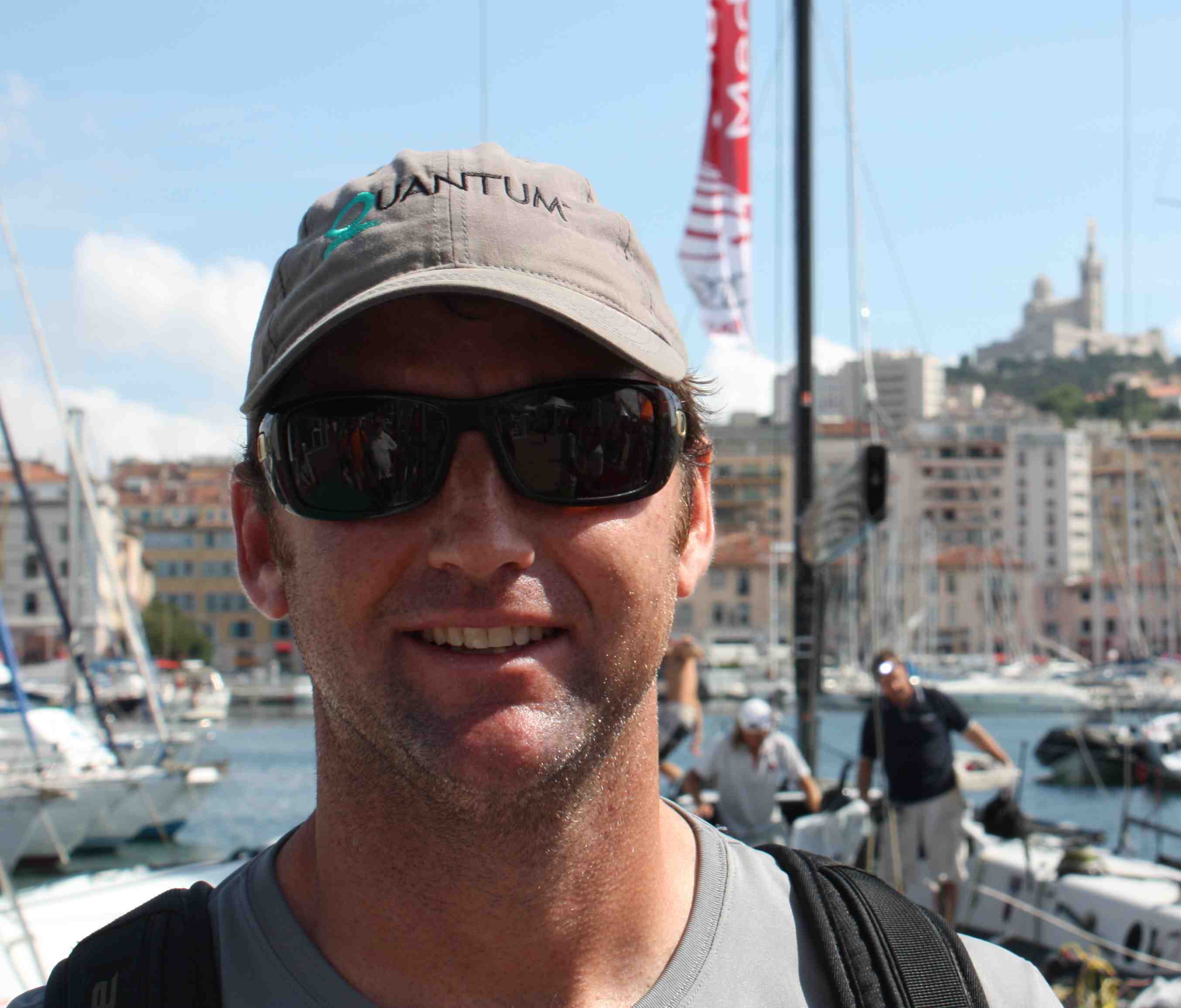 Tom Burnham talks about the importance to applying a tactician's brain to your job, even if like him you're at the front end of the boat doing the muscle work. Tom did the pit on board World Championship winning TP52 Quantum Racing, and talks about the stuff that he wants to know from the brain's trust at the back of the boat...
Tom Burnham talks about the importance to applying a tactician's brain to your job, even if like him you're at the front end of the boat doing the muscle work. Tom did the pit on board World Championship winning TP52 Quantum Racing, and talks about the stuff that he wants to know from the brain's trust at the back of the boat...

Holding Your Lane: Etchells World Champ tells how
Read More
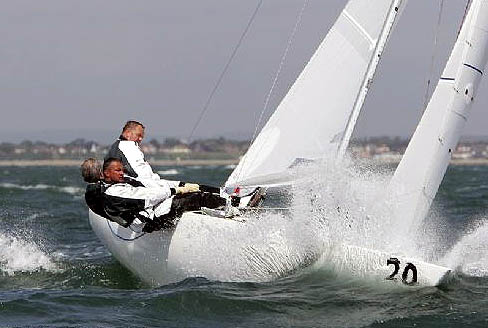
Holding your position is one of those skills that separates the good from the average sailors. "He's good at holding his lane," is one of those phrases you'll hear about a really talented sailor. Etchells world champion Andy Beadsworth reveals some clues to this dark art...

How to sail the Etchells fast: tips from a triple World Champion
Read More

Bill Hardesty has competed in three Etchells 22 World Championships, and he's won every time! In this half-hour chat, Bill shares some of his tips and insights into how to campaign this competitive keelboat to the max...

Upwind in Breeze
Read More
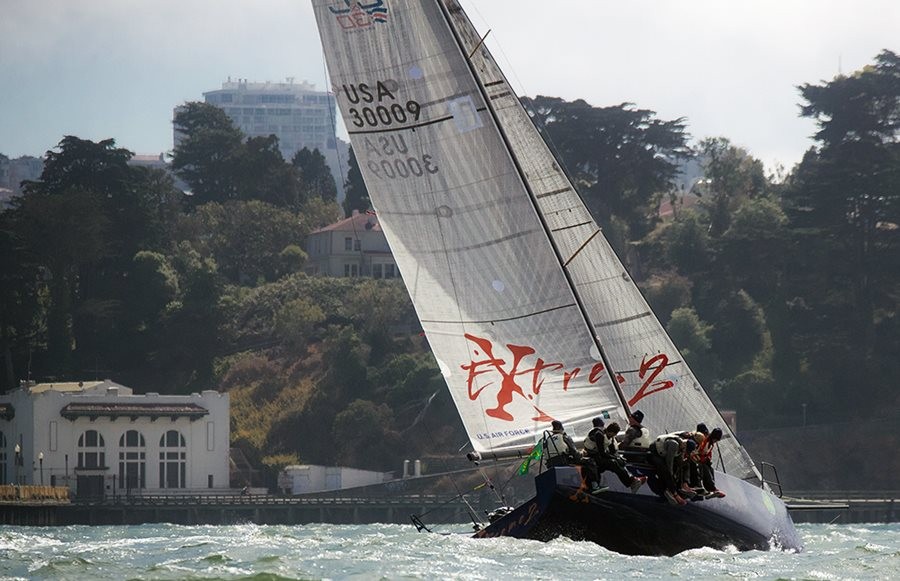
Big breeze can be one of the most fun conditions to sail in and with Quantum’s Dave Flynn four simple tips you can also be fast and efficient. Strong wind can be a tricky condition to sail in. However, with some small tweaks and considerations, you can make big gains on the racecourse or more comfortably get to your destination. Here is what you need to know to get up to speed, balance the luff, manage heel, and crush the waves...

5 Reasons to Gybe-Hoist
Read More
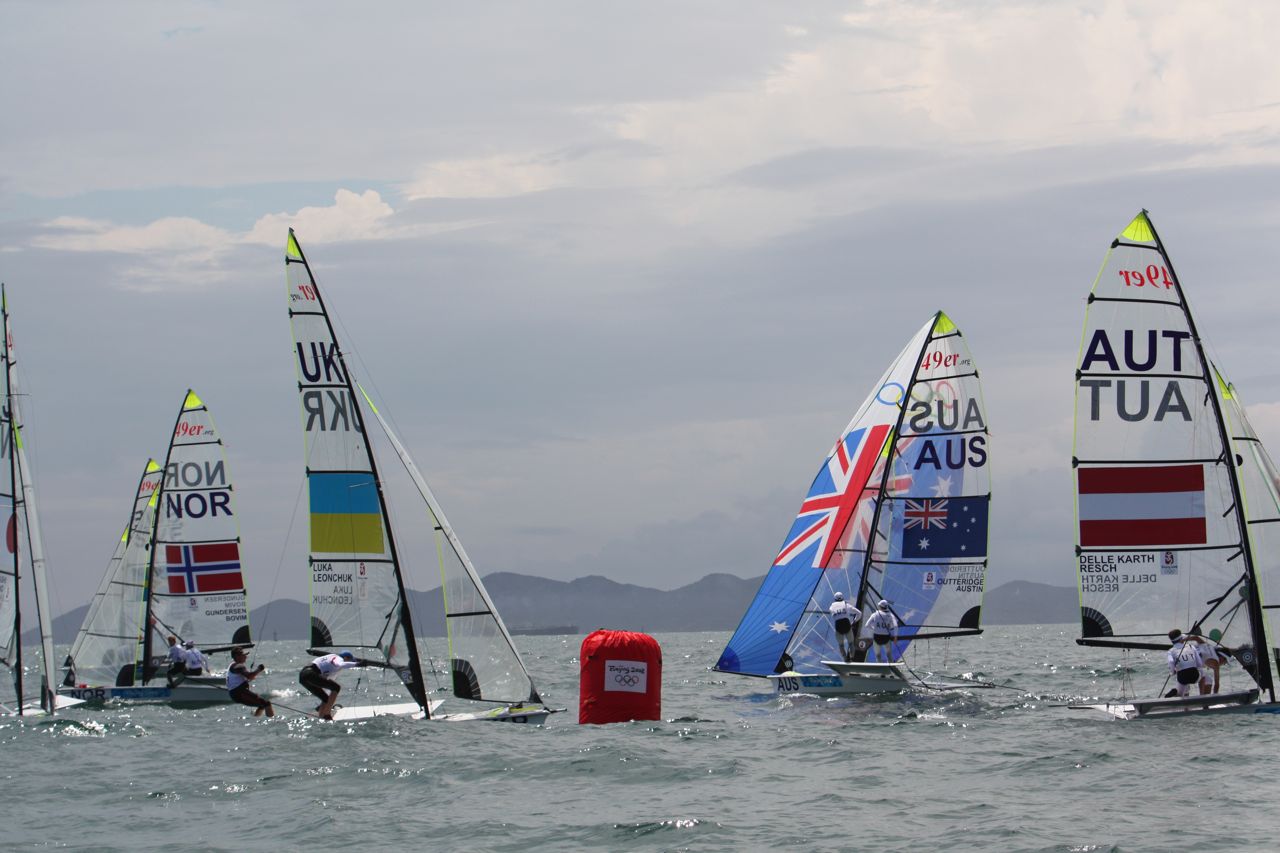 Gybe-hoisting is a tricky manoeuvre to get right, but there can be great tactical reasons for giving it a go. Here are FIVE of the biggest reasons to consider going for this challenging but potentially rewarding move on the race course. This applies mainly to asymmetric dinghies, but there are some valid lessons here for all sailors....
Gybe-hoisting is a tricky manoeuvre to get right, but there can be great tactical reasons for giving it a go. Here are FIVE of the biggest reasons to consider going for this challenging but potentially rewarding move on the race course. This applies mainly to asymmetric dinghies, but there are some valid lessons here for all sailors....
